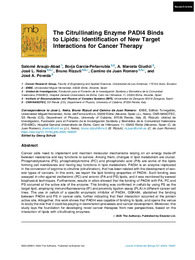Título :
The Citrullinating Enzyme PADI4 Binds to Lipids: Identification of New Target Interactions for Cancer Therapy |
Autor :
Araujo-Abad, Salomé
García-Peñarrubia, Borja
Giudici, Ana Marcela
Neira Faleiro, José Luis
Rizzuti, Bruno
de Juan Romero, Camino
Poveda, José A. |
Editor :
Elsevier |
Departamento:
Departamentos de la UMH::Agroquímica y Medio Ambiente |
Fecha de publicación:
2025 |
URI :
https://hdl.handle.net/11000/37790 |
Resumen :
Cancer cells need to implement and maintain molecular mechanisms relying on an energy trade-off between resistance and key functions to survive. Among them, changes in lipid metabolism are crucial. Phosphatidylserine (PS), phosphatidylcholine (PC) and phosphatidic acid (PA) are some of the lipids forming cell membranes and having key functions in lipid metabolism. PADI4 is an enzyme implicated in the conversion of arginine to citrulline (citrullination), that has been related with the development of several types of cancers. In this work, we report the lipid binding properties of PADI4. Such binding was assayed in vitro against zwitterionic (PC) and anionic (PA and PS) lipids, and it was monitored by several biophysical techniques. Furthermore, results in silico showed that the binding of PADI4 with PA, PC and PS occurred at the active site of the enzyme. This binding was confirmed in cellulo by using PS as the target lipid, employing immunofluorescence (IF) and proximity ligation assay (PLA) in different cancer cell lines. The use in cellulo of a specific enzymatic inhibitor of PADI4, GSK484, abolished the binding between PADI4 and PS in cancer cells, further indicating that their interaction occurred at the protein active site. Altogether, this work shows that PADI4 was capable of binding to lipids, and opens the venue to study the role that it could be playing in deimination processes and cancer development. Moreover, this study lays the foundation for developing novel cancer therapies from new perspectives, based on the interaction of lipids with citrullinating enzymes.
|
Palabras clave/Materias:
Protein-lipid interactions
Citrullinating enzyme
Proximity ligation assay
Molecular docking
Immunofluorescence |
Área de conocimiento :
CDU: Ciencias puras y naturales |
Tipo de documento :
info:eu-repo/semantics/article |
Derechos de acceso:
info:eu-repo/semantics/openAccess
Attribution-NonCommercial-NoDerivatives 4.0 Internacional |
DOI :
https://doi.org/10.1016/j.jmb.2025.169297 |
Publicado en:
ournal of Molecular Biology (JMB) |
Aparece en las colecciones:
Artículos Agroquímica y Medio Ambiente
|
 La licencia se describe como: Atribución-NonComercial-NoDerivada 4.0 Internacional.
La licencia se describe como: Atribución-NonComercial-NoDerivada 4.0 Internacional.
.png)
